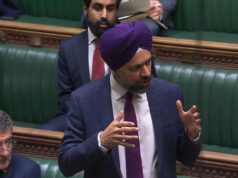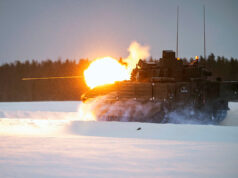NATO has launched its new Allied Reaction Force (ARF), with the UK taking a leading role in this step to boost the alliance’s collective defence capabilities.
The ceremony, held on July 1 in Solbiate Olona, Italy, marks “the beginning of a new era for NATO’s military readiness”.
Replacing the NATO Response Force (NRF), the ARF is designed to be a strategic, high-readiness force that can be quickly deployed to respond to any threat.
This new structure is part of NATO’s updated defence strategy, agreed upon during the Vilnius summit in 2023, and includes a three-tiered force model:
- Tier 1: 100,000 troops ready within 10 days.
- Tier 2: 200,000 troops ready within 10 to 30 days.
- Tier 3: 500,000 troops ready for action within 30 to 180 days.
The ARF offers NATO a flexible, multi-domain force that can strengthen deterrence in peacetime and respond rapidly in crises. It will operate under the command of the NATO Rapid Deployable Corps Italy (NRDC-ITA) for the next three years. NRDC-ITA has undergone extensive training and exercises to prepare for this role, culminating in Exercise Steadfast Deterrence 24, which validated its readiness.
A NATO spokesperson stated in a press release, “The ARF offers the Alliance a strategic, high-readiness, multi-domain and multinational capability that can be deployed immediately to strengthen deterrence and support the Alliance’s defence.”
The British Army’s 1st (UK) Division is now leading the land component of the ARF, ready to handle a range of scenarios from humanitarian assistance to combat operations. This demonstrates the UK’s commitment to NATO’s collective defence and its ability to rapidly respond to emerging threats.
NRDC-ITA’s transition to an ARF HQ marks a shift from its traditional high readiness role to a more strategic focus. This change underscores Italy’s dedication to the Alliance and the defence of the Euro-Atlantic area.
This development is part of NATO’s Concept for the Deterrence and Defence of the Euro-Atlantic Area (DDA), which focuses on countering major threats from Russia and terrorist groups. The ARF plays a crucial role in this strategy by providing a rapid, flexible response to a wide range of threats, say the Alliance.
The ARF will continue to enhance its capabilities through a series of exercises in 2024 and 2025.













Interesting. 1 UK Div has also been labelled as the UK “Global Response Force” which was previously just 16 AA Bde. It can be seen as our light Division, where our other Division, 3 UK, is the heavy one.
The glossy terminology and spin ignores the gaps. 1 UK only has 2 deployable brigades, 16 AA and 7 LMB, rather than the usual 3, as 4 LB does not have enough regular CS CSS formations to make it truly deployable. Dern and I have lamented this many times here.
Even this sub par divisional set up was only achieved by rearranging the deck chairs and moving 16AA Bde into it.
The Division has a supporting Logistics Brigade, but lacks it’s own AD Regiment and in artillery beyond 2 Regiments of Light Guns. However, it’s good to see an effort over several years to make it more deployable than the previous paper division that it was, with improvements to Signals, EW, and Intelligence units.
My question: Where does the ARRC sit in this new set up? The UK has been framework nation for the ARRC for many years, with its Commander, many of the HQ staff, a Signals Bde and 3 UK Division, our main combat formation, assigned to it.
Good piece Daniele.
Good summation, I too am glad to see 1st Division being more than a paper division. They mentioned it has 8 brigades now on forces news which seems like a lot.
8 Brigades. 🙄 This is because there are other Brigades that were once part of “Theatre Troops” then “Force Troops” and now “Field Troops” that were at one time shoved in it as part of the constant army restructuring that to me at least made little sense. Like 8 Engineer Bde.
Those Brigades are from the CS CSS arms and services and are often admin formations with either no deployable role as a complete brigade, or, those Bdes components are themselves found in other formations, like supporting 3 Division.
They should be visualized as “Corps Troops” and assigned accordingly. The Medical Regiments of 2 Med Bde ( now a group ) the Royal Signals Regiments, the RLC enablers in 101,102 and 104 Bdes, the ISTAR assetsthat were once part of 1 ISR Bde but now split into smaller groups.
But the army website or Forces News saying that gives the impression of a bigger more powerful Division than odd the case.
Back in 2010, 1 Div was known as the Adaptable Force and had 7 Infantry Brigades! Behind the spin, reality was of those 7 2 were deployable, rest were regional formations like 160(W)
If the army ever organises itself correctly, along the old tried and tested lines, you’d have 3 Division, with 3 Brigades, 1 Division, with 3 Brigades, 6 Division, now to be ASOC, with ASOB and 77, and all those other Brigades in Field Army Troops
I’m still awaiting this since 2010.
And If all that is TLDR for some, or too complex to get the head round, as the army ORBAT can be:
An Army must always be measured, in my view, by the number of deployable Brigades, with their supporting CS CSS, that it can put in the field.
We have 4, or 5 if you include 1 DRSB.
12 and 20 Armoured.
7 Light Mechanized.
16 Air Assault.
All the other Brigades are supporting, or specialist, like ASOB, like SFA, like 77.
I think you should definitely include 1 DRSB, it’s much more than an artillery force and it’s very much a maneuverer element .
Sure, Jim, I’m very aware what it comprises.
My methodology for being a “deployable” Brigade is whether the Brigade can deploy as a self contained formation with its own enablers, so regular CSS.
DRSB does not have those, beyond a REME Bn. It’s “CSS Group” is a composite formation of reservist RAMC and RLC sub units from several different regiments that have only combined once AFAIK when the Bde has its first major exercise.
Dern labelled it’s recc side a “cavalry group” which I liked, and even had the famous 3rd Regiment of Tanks in it!
Infantry? Zilch, guess they’re task org’d as needed.
1 Division has
7 Light Mech Brigade, a large infantry brigade on foxhounds, with a jackal cavalry regiment and light gun support.
16AA, Paras and air assault infantry.
4 Light Brigade, a force of motorised infantry battalions without supporting units (can’t deploy)
11 SFAB, consisting of 4 Light Infsntry battalions equipped and organised to train friendly forces.
19th Light Brigade, a large pool of reservist formations, too large to be an effective Brigade, but unsupported.
102 logistics Brigade for divisional supply
8 Engineer brigade.
Of those, the deployable strength is limited to 7, 16, 102, and 8 with a shoutout to 11.
So it might seem like a lot, but it isn’t.
The Division should be stripped most of those save 7,16,102, plus the Divisional Signal Regiment and IC Battalion.
Give 4 it’s regular CSS and we have a Division.
In a fantasy world an extra Divisional GS Engineer Regiment and UAS, artillery formations, so both 1 and 3 would be supported.
1 Div lacks in signals too but assume as the kit is so much lighter there’s less CIS support needed in LM or L Bdes.
I can see an argument for 8 as maneuver support and basing construction in the GRF role. But 19 needs dividing in half to make decent reserve formations.
1 UK division with 4, 7, 16, 8 and 102
2 division with 11 and two reserve brigades.
Yes, its fair,l. I personally feel more at ease with it in Field Troops so it’s components get allocated downwards into either 1 or 3 as needed.
Your 2 Division, with 11, touches on another point I recall you previously made. That they could also be the framework around expansion, training of additional British formations, not just Ukrainian and other nations forces.
Paired with reserve Brigades, seems perfectly sensible and logical..
ARRC remains its own 3* command but without anything permanently orbatted to it besides 104 log, and signals.
In theory in Wartime it would command 3 uk division along with 2-3 allied divisions and a SOF task force (I guess the SOF force might realign to ARF?)
I think this feels less like a ? Over ARRC and more over VJTF.
Ah, Dern.
Thanks, so no real change at Insworth then!
Yes, VJTF seems more aligned, and confused, with this.
1st of July, not July 1.
If you write the article, you can write it however you please.
Mmmm. So what are France, and Spain (I’d also mention Italy tho they are more onboard with us tbh) doing in all of this? Given their sub par performance in Ukraine snd letting migrants wander over the Channel I’m not sure we should be supporting it that much. The JEF seems a better place to focus – we get respect from them not problems.
Slightly OT, but has anyone read about Robert Johnson’s work as “Director of the Secretary of State’s Office for Net Assessment and Challenge; he led a 25-person team charged with wargaming and using research, analysis, and external think tanks to ensure the UK’s defensive capabilities were at “peak” performance”.
It makes for dire reading but nothing that we here didn’t already know.
Sources are the Financial Times, Business Insider, big news network and the msn website.
No, didn’t know of it.
They could save a fortune and just ask the SME and other posters here.
It’s a contradiction in terms to expect “peak” performance” from forces cut to their lowest, fewest, for donkeys years.
Such a great comment!
Perhaps Robert Johnson and his study team should have looked for the ‘best that we can manage, despite cutbacks.’